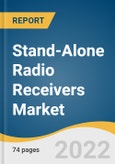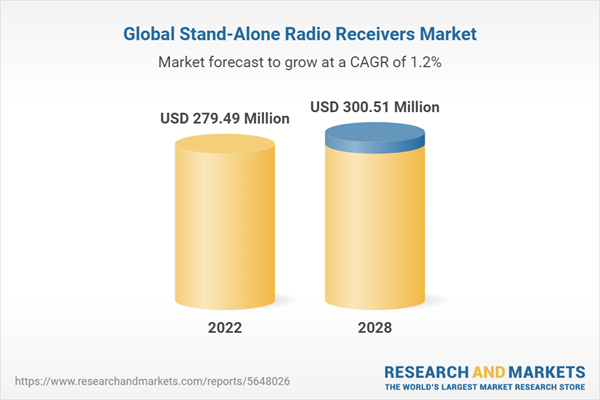The global stand-alone radio receivers market size is expected to reach USD 300.51 million by 2028, registering a CAGR of 1.2% during the forecast period. The rising middle-class population in emerging nations such as China, India, and Brazil is driving the demand for stand-alone radio receiver devices. Major players operating in the stand-alone radio receiver industry are focusing on developing easy-to-use and high-performing devices due to steady demand from the consumer side.
The increasing consumer spending and disposable income are driving the growth of the market for stand-alone radio receivers during the forecast period. This industry has progressed substantially over the last few years due to various novel technological advancements. The emergence of the latest devices and technological spread is anticipated to be the major driving factor for the growth during the forecast period. However, the increasing adoption of technologically advanced radio receivers has led to lower sales of traditional standalone receivers, which is estimated to pose a threat and challenge to the market growth.
The impact of the COVID-19 pandemic on the standalone radio receiver market is short-term, as only the manufacturing and supply chain is delayed. As the situation improves, manufacturing, supply chains, as well as demand for stand-alone radio receivers are expected to witness a surge. The COVID-19 lockdown would help firms to think about further advancements in stand-alone radio receivers to increase efficiency.
Several governments are taking initiatives and reforms in energy-effective consumer electronics, which has resulted in a remarkable impact on the market for stand-alone radio receivers. Stringent regulations are being implemented in North America related to energy efficiency. This industry faces numerous challenges due to supply-related delays, changing consumer preferences, and production disorders.
This market is at an inflection point in terms of product development and manufacturing. In order to meet future challenges, the planning of the conventional supply chain is not satisfactory. Therefore, to cope with the ever-evolving customer preferences, shrinking margins, and intense competition, the OEMs are focusing on constructing a well-organized supply chain.
The offline distribution channel segment contributed to the highest share of over 83% of the global market revenue in 2021. The offline segment includes hypermarkets, conventional stores, specialty stores, supermarkets, independent retail stores, etc. The mounting organized retail sector in developing economies such as China, Malaysia, and Japan is anticipated to augment the demand for stand-alone radio receiver products in the coming years. Thus, all these factors are expected to boost the growth of this segment during the forecast period.
North America held the majority of the industry share of over 60% in 2021, owing to the high radio reach into this population. Over the half of world’s radio receiver product revenue is generated from North America as the majority of the radio listeners are present in this region. Furthermore, the steady sales of stand-alone radio receiver products are propelling the growth of this market. A high concentration of the working population, coupled with higher disposable income in Canada and the U.S., is further anticipated to fuel the market growth.
The increasing consumer spending and disposable income are driving the growth of the market for stand-alone radio receivers during the forecast period. This industry has progressed substantially over the last few years due to various novel technological advancements. The emergence of the latest devices and technological spread is anticipated to be the major driving factor for the growth during the forecast period. However, the increasing adoption of technologically advanced radio receivers has led to lower sales of traditional standalone receivers, which is estimated to pose a threat and challenge to the market growth.
The impact of the COVID-19 pandemic on the standalone radio receiver market is short-term, as only the manufacturing and supply chain is delayed. As the situation improves, manufacturing, supply chains, as well as demand for stand-alone radio receivers are expected to witness a surge. The COVID-19 lockdown would help firms to think about further advancements in stand-alone radio receivers to increase efficiency.
Several governments are taking initiatives and reforms in energy-effective consumer electronics, which has resulted in a remarkable impact on the market for stand-alone radio receivers. Stringent regulations are being implemented in North America related to energy efficiency. This industry faces numerous challenges due to supply-related delays, changing consumer preferences, and production disorders.
This market is at an inflection point in terms of product development and manufacturing. In order to meet future challenges, the planning of the conventional supply chain is not satisfactory. Therefore, to cope with the ever-evolving customer preferences, shrinking margins, and intense competition, the OEMs are focusing on constructing a well-organized supply chain.
The offline distribution channel segment contributed to the highest share of over 83% of the global market revenue in 2021. The offline segment includes hypermarkets, conventional stores, specialty stores, supermarkets, independent retail stores, etc. The mounting organized retail sector in developing economies such as China, Malaysia, and Japan is anticipated to augment the demand for stand-alone radio receiver products in the coming years. Thus, all these factors are expected to boost the growth of this segment during the forecast period.
North America held the majority of the industry share of over 60% in 2021, owing to the high radio reach into this population. Over the half of world’s radio receiver product revenue is generated from North America as the majority of the radio listeners are present in this region. Furthermore, the steady sales of stand-alone radio receiver products are propelling the growth of this market. A high concentration of the working population, coupled with higher disposable income in Canada and the U.S., is further anticipated to fuel the market growth.
Stand-Alone Radio Receivers Market Report Highlights
- Asia Pacific is expected to register the fastest growth of 2.6% from 2022 to 2028, owing to the rising demand for radio receivers in developing countries, including India and China
- North America dominated the market by contributing over 60% of the global revenue in 2021, due to the rising adoption of radio receivers among millennials in this region
- The offline distribution channel segment held the largest share in 2021, contributing to over 83% of the overall revenue, owing to the growth of the organized retail sales sector all over the world
Table of Contents
Chapter 1. Methodology and Scope
Chapter 2. Executive Summary
Chapter 3. Stand-Alone Radio Receivers Market Variables, Trends & Scope
Chapter 4. Consumer Behavior Analysis
Chapter 5. Stand-Alone Radio Receivers Market: Distribution Channel Estimates & Trend Analysis
Chapter 6. Stand-Alone Radio Receivers Market: Regional Estimates & Trend Analysis
Chapter 7. Competitive Analysis
Chapter 8. Company Profiles
List of Tables
List of Figures
Companies Mentioned
- Sony
- Panasonic
- Philips
- Bose
- Roberts Radio
- Tivoli Audio
- Ruark Audio
Methodology

LOADING...
Table Information
| Report Attribute | Details |
|---|---|
| No. of Pages | 74 |
| Published | May 2022 |
| Forecast Period | 2022 - 2028 |
| Estimated Market Value ( USD | $ 279.49 Million |
| Forecasted Market Value ( USD | $ 300.51 Million |
| Compound Annual Growth Rate | 1.2% |
| Regions Covered | Global |
| No. of Companies Mentioned | 7 |









